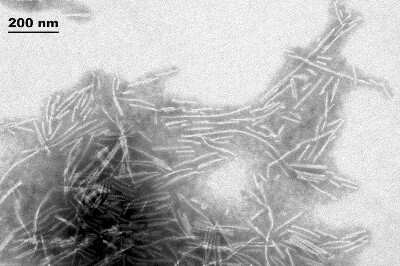Recombinant Human alpha-Synuclein Active, Filaments Protein
Novus Biologicals, part of Bio-Techne | Catalog # NBP3-14770

Key Product Details
Conjugate
Unconjugated
Applications
Microscopy, Functional Assay, SDS-PAGE, Western Blot
Product Specifications
Description
A full length recombinant protein of Human alpha-Synuclein
Source: E. coli
Uniprot ID: P37840
Purity
>95%, by SDS-PAGE
Localization
Cytoplasm, Membrane, Nucleus
Protein / Peptide Type
Recombinant Protein
Scientific Data Images for Recombinant Human alpha-Synuclein Active, Filaments Protein
Electron Microscopy: Recombinant Human alpha-Synuclein Active, Filaments Protein [NBP3-14770] - TEM of Active Human Recombinant alpha-Synuclein Protein Filaments (NBP3-14770)
Electron Microscopy: Recombinant Human alpha-Synuclein Active, Filaments Protein [NBP3-14770] - TEM of Active Human Recombinant alpha-Synuclein Protein Filaments (NBP3-14770)
Formulation, Preparation and Storage
NBP3-14770
| Preparation Method | Ion-exchange Purified |
| Formulation | PBS pH 7.4 |
| Preservative | No Preservative |
| Concentration | Please see the vial label for concentration. If unlisted please contact technical services. |
| Shipping | The product is shipped with dry ice or equivalent. Upon receipt, store it immediately at the temperature recommended below. |
| Stability & Storage | Store at -80C. Avoid freeze-thaw cycles. |
Background: alpha-Synuclein
A number of studies have revealed that alpha-synuclein aggregation is a hallmark feature in a number of neurodegenerative diseases, referred to as synucleinopathies (2-4). Alpha-synuclein protein aggregates are a large component of Lewy bodies that are present in Parkinson's disease (PD), Lewy body dementia (LBD), and multiple system atrophy (1-6). Research has shown phosphorylation of alpha-synuclein at Ser129 moves the protein from the nucleus to the cytoplasm and promotes fibril formation associated with synucleinopathies (1,2,5). Recent studies also suggest that alpha-synuclein accumulation can prevent mitochondrial import machinery causing mitochondrial dysfunction that is often observed in neurodegeneration (5). It is thought that preventing alpha-synuclein aggregation may prevent PD, thus alpha-synuclein is a target for many potential therapeutic interventions aimed at decreasing aggregate formation or increasing clearance (1,2,4-6).
References
1. Villar-Pique, A., Lopes da Fonseca, T., & Outeiro, T. F. (2016). Structure, function and toxicity of alpha-synuclein: the Bermuda triangle in synucleinopathies. Journal of neurochemistry. https://doi.org/10.1111/jnc.13249
2. Emamzadeh F. N. (2016). Alpha-synuclein structure, functions, and interactions. Journal of research in medical sciences : the official journal of Isfahan University of Medical Sciences. https://doi.org/10.4103/1735-1995.181989
3. Burre J. (2015). The Synaptic Function of alpha-Synuclein. Journal of Parkinson's disease. https://doi.org/10.3233/JPD-150642
4. Lashuel, H. A., Overk, C. R., Oueslati, A., & Masliah, E. (2013). The many faces of alpha-synuclein: from structure and toxicity to therapeutic target. Nature reviews. Neuroscience. https://doi.org/10.1038/nrn3406
5. Rocha, E. M., De Miranda, B., & Sanders, L. H. (2018). Alpha-synuclein: Pathology, mitochondrial dysfunction and neuroinflammation in Parkinson's disease. Neurobiology of disease. https://doi.org/10.1016/j.nbd.2017.04.004
6. O'Leary, E. I., & Lee, J. C. (2019). Interplay between alpha-synuclein amyloid formation and membrane structure. Biochimica et biophysica acta. Proteins and proteomics. https://doi.org/10.1016/j.bbapap.2018.09.012
Alternate Names
NACP, PARK1, PARK4, SNCA, Synuclein-alpha
Gene Symbol
SNCA
Additional alpha-Synuclein Products
Product Documents for Recombinant Human alpha-Synuclein Active, Filaments Protein
Product Specific Notices for Recombinant Human alpha-Synuclein Active, Filaments Protein
Please note that the 200ug and 500ug sizes are sent in 2x100ug and 5x100ug vials, respectively
This product is for research use only and is not approved for use in humans or in clinical diagnosis. This product is guaranteed for 1 year from date of receipt.
